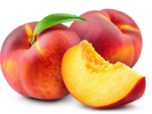
KJFM NEWS — Garden Talk is produced monthly at the Adair County University of Missouri Extension Center in Kirksville, Mo.
July is national peach month and usually signals the beginning of peaches ripening in Missouri. Our fascination with peaches is not surprising. Not only is its taste unique, it also is one of our most versatile fruits. It can be eaten fresh, dried, sliced with cream, pickled, spiced, made into jam, baked into a pie, distilled into an elegant liqueur or frozen with ice cream.
The peach was probably was carried from China to Persia along the silk trade routes in the pre-Christian era. The Spaniards are credited with introducing peach to the new world in the sixteenth century and by 1571 three types of peach were being produced in Mexico. Evidently, Native Americans were fond of peaches and William Penn wrote there was “not an Indian plantation without them.” Oddly enough, peach did not make it into England or France until the seventeenth century but became a popular (although rare) treat when it did.
The peach is not the hardiest of fruits. It requires a lot of care such as annual pruning, fertilization, and monitoring and spraying for insects and diseases. Flower buds are endangered at temperatures around -10 degrees while -20 degrees will frequently kill wood. Additionally, peaches suffer the tendency to be coaxed out of dormancy by late winter or early spring warm weather. This causes the flower buds to loose their hardiness and makes them quite susceptible to spring frosts. All these things are the reason it is difficult to grow peach trees in northeast Missouri.
Peaches can be separated into two distinct types: clingstone and freestone. As the name implies the flesh of the peach clings to the seed (pit) of the former but can be loosened from the latter with relative ease. Most of the peaches available for fresh consumption are of the freestone type. Additionally, peaches can be separated into those with yellow flesh versus those with white flesh. Many consider white-fleshed peaches to be a bit less acidic in nature than yellow-fleshed ones, giving them a milder, more delicate flavor with honey-like or vanilla overtones.
Whatever their color, peaches are rather delicate and need to be handled carefully to prevent bruising. Ripeness can be judged both by color, firmness and aroma of the peach. Select those that are fully colored (lacking green on the underside) and just beginning to soften. A creamy or golden undertone (ground color) probably is a better indicator of maturity than the rosy blush most peaches develop. Peaches also should emit a strong “peachy” fragrance and be free from bruises. Ripe peaches can be stored in a refrigerator for up to a week, depending on their degree of maturity, but should be allowed to come to room temperature before consumption for ultimate eating pleasure.
Source of information: Dr. David Trinklein, University of Missouri Extension
